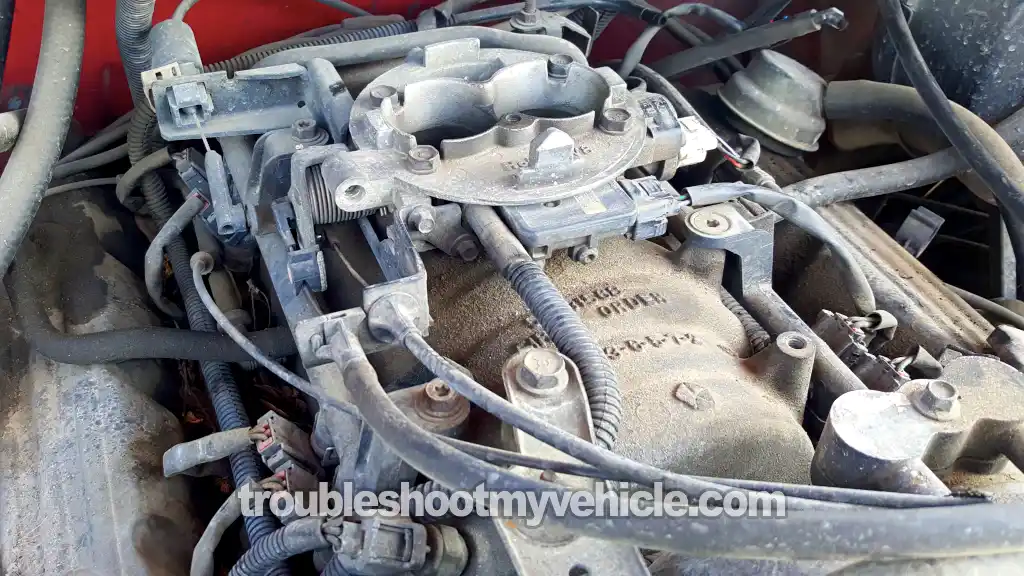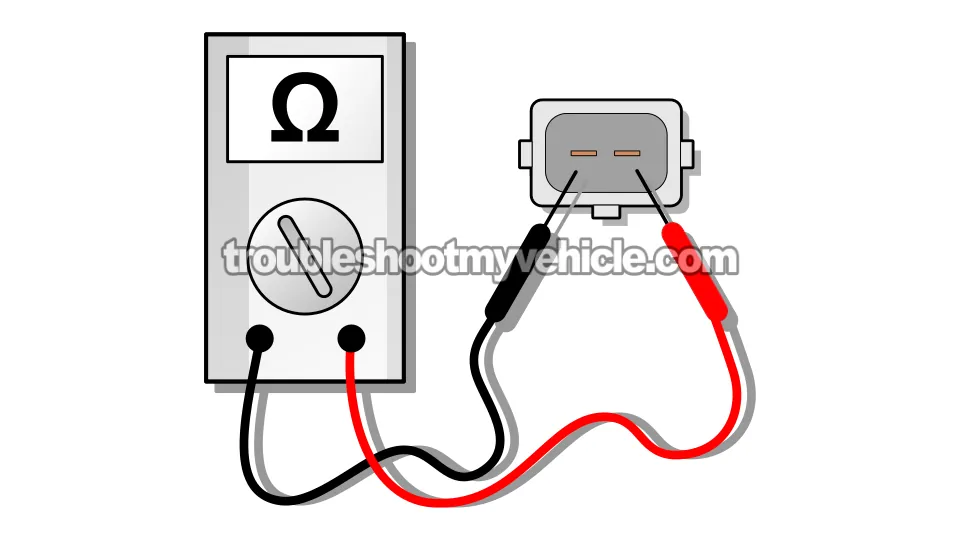
This tutorial will walk you through how to check the fuel injectors on your V8 Dodge Ram pickup using a multimeter to do a very simple resistance test.
Fuel injectors don't fail often, but when one does, you're gonna feel it —rough idle or a cylinder misfire. So if your pickup's acting up, this test can help you get to the bottom of it.
Contents of this tutorial:
APPLIES TO: This tutorial applies to the following vehicles:
1992-1993:
- Dodge Ram 150 Pickup 5.2L V8: 1992, 1993.
- Dodge Ram 250 Pickup 5.2L V8: 1992, 1993.
- Dodge Ram 150 Pickup 5.9L V8: 1993.
- Dodge Ram 250 Pickup 5.9L V8: 1993.
- Dodge Ram 350 Pickup 5.9L V8: 1993.
1994-1999:
- Dodge Ram 1500 Pickup 5.2L V8: 1994, 1995, 1996, 1997, 1998, 1999.
- Dodge Ram 2500 Pickup 5.2L V8: 1994, 1995, 1996, 1997, 1998.
- Dodge Ram 1500 Pickup 5.9L V8: 1994, 1995, 1996, 1997, 1998, 1999.
- Dodge Ram 2500 Pickup 5.9L V8: 1994, 1995, 1996, 1997, 1998, 1999.
- Dodge Ram 3500 Pickup 5.9L V8: 1994, 1995, 1996, 1997, 1998, 1999.
WIRING DIAGRAMS:
- Fuel Injector Wiring Diagram (1992 5.2L, 5.9L V8 Dodge Ram Pickup).
- Fuel Injector Wiring Diagram (1993 5.2L, 5.9L V8 Dodge Ram Pickup).
- Fuel Injector Circuit Wiring Diagram (1994-1995 5.2L, 5.9L V8 Dodge Ram Pickup).
- Fuel Injector Circuit Wiring Diagram (1996-1997 5.2L, 5.9L V8 Dodge Ram Pickup).
- Fuel Injector Circuit Wiring Diagram (1998-2000 5.2L, 5.9L V8 Dodge Ram Pickup).
Symptoms Of A Bad Fuel Injector
You probably already know that every cylinder in your Dodge Ram's V8 engine needs three critical things to create power:
- Air.
- Fuel.
- Spark.
Take away any one of those and you've got a "dead" cylinder. If one of your fuel injectors quits working, you'll notice one or more of the following symptoms:
- Rough idle: The engine shakes and stumbles at idle.
- Misfires: You'll feel hesitation or jerking when you hit the gas.
- Misfire trouble codes (DTCs): On OBD-II pickups (1996 and up), you'll see codes like:
- P0300: Random Misfire Across Multiple Cylinders
- P0301: Misfire In Cylinder #1
- P0302: Misfire In Cylinder #2
- P0303: Misfire In Cylinder #3
- P0304: Misfire In Cylinder #4
- P0305: Misfire In Cylinder #5
- P0306: Misfire In Cylinder #6
- P0307: Misfire In Cylinder #7
- P0308: Misfire In Cylinder #8
- Weak acceleration: The pickup feels sluggish when you step on the gas pedal.
- Bad gas mileage: Fuel economy drops off noticeably.
So, what knocks a fuel injector out of commission? Most of the time, it's just age. But not always. Here are the three main ways injectors fail:
- Internal failure: The injector suffers an internal failure and it stops spraying any fuel.
- Clogged up: It sprays, but not enough to keep the cylinder happy.
- Electrical issue: Stuck open all the time —usually caused by an internal fault in the fuel injection computer or an electrical issue in the wiring.
This tutorial focuses on the two most common issues: an injector that's internally shorted and won't spray at all, and one that's partially or fully clogged.
Where To Buy The Fuel Injector And Save
You can grab a replacement fuel injector for your Dodge Ram pickup at pretty much any local auto parts store —but be ready to pay a premium for it.
I recommend checking prices online first. Even if you don't buy it there, at least you'll know what it should cost and how much you're really saving (or not).
Disclosure: As an Amazon Associate, I earn from qualifying purchases. If my tutorials help you, using these links is an easy way to support the site at no extra cost to you. Thank you!
Not sure if the above fuel injector fits your particular Dodge Ram pickup? Don't worry, once you get to the site, they'll make sure it fits by asking you the particulars of your vehicle. If it doesn't fit, they'll find you the right one.
Fuel Injector Resistance Specifications
| Year | Engine | Resist. |
|---|---|---|
| 1992 | 5.2L | 12.5-16.5 Ohms |
| 1993-1997 | 5.2L/5.9L | 13.3-15.7 Ohms |
| 1998-1999 | 5.2L/5.9L | 10-16 Ohms |
NOTE: All resistances at: 68°F/20°C
TEST 1: Fuel Injector Resistance Test
The test instructions below are written with the idea that you'll be checking all eight fuel injectors —mainly because they're super accessible. But you don't have to test them all if you don't want to.
If you're only planning to check one, I still suggest testing at least two more so you've got something to compare the readings to when you're done.
NOTE: Don't have a multimeter or need to upgrade yours? This is the one I use and recommend: Tekpower TP8268 AC/DC Auto/Manual Range Digital Multimeter (at: amazon.com).
IMPORTANT: The resistance of the fuel injectors must be done with the engine cold (room temp). If the engine has been running for any length of time, let it cool down completely.
Alright, here's what you need to do:
- 1
Unplug the fuel injector from its electrical connector.
- 2
Set your multimeter to read Ohms (Ω).
- 3
Check the resistance across the two terminals on the fuel injector.
The resistance should be within the indicated spec: Fuel Injector Resistance Specifications. - 4
Write down the resistance reading.
Make sure you note which cylinder the injector belongs to. - 5
Repeat steps 1 through 4 for the other 7 injectors.
Record each resistance value along with its matching cylinder.
Now, let's break down what your results mean:
CASE 1: All 8 injectors show a resistance with the factory specification. That tells us the injectors don't have an internal short-circuit or open-circuit problem.
Still, even if they're internally fine, one or more injectors might be clogged. Check out this section for more help: Fuel Injector Diagnostic Strategy.
CASE 2: One (or more) injector shows a totally different resistance from the specification. Go ahead and retest that injector.
If the resistance reading stays the same and it's way off compared to the specification, that injector's no good. Time to replace it.
Fuel Injector Diagnostic Strategy
In this part, I'll walk you through the quickest way I've found to figure out which fuel injector is causing trouble.
This is a step-by-step diagnostic method that'll help you track down whether a bad injector (or something else) is behind your Dodge Ram pickup's engine's misfire or rough idle. And the best part —you don't need pricey tools to do it!
Here's how I go about it:
1.) CHECK THE FUEL INJECTOR SPRAY:
Since the injectors are so accessible, I remove the "dead" cylinder's injector and connect it up to a DIY injector cleaner tool to watch the spray pattern directly.
The result of this test instantly tells me if the injector's clogged or faulty. I've written a full step-by-step tutorial on how to do this and you can find it here:
2.) USE THE PROCESS OF ELIMINATION:
This is the method I've used to systemically troubleshoot the cause of the cylinder's misfire. It's worked for me 100% of the time:
- Step 1: Track down the cylinder that's not firing
- This is hands-down the most important part. On OBD-II pickups (1996+), you can use a basic scan tool or code reader to pull the trouble codes from your pickup's computer and spot which cylinder's dead.
- On OBD-I pickups, you can go old-school and do a manual cylinder balance test —this is my go-to method when I'm chasing a misfire.
- Step 2: Confirm that cylinder's getting spark
- Just hook up a spark tester to the spark plug wire on the misfiring cylinder, then crank the engine. If you see spark, it's getting fire.
- Also make sure the spark plug boot and plug aren't soaked in oil —that can kill spark delivery.
- While you're at it, pull the plug and check for cracks or carbon tracking. Don't skip this —it's easy to miss and can cause weird issues.
- Check out this real-world case of carbon tracks messing things up: Carbon Tracks Are A Common Cause Of Ignition Misfires (via easyautodiagnostics.com).
- This tutorial will also help:
- Step 3: If it has spark, check the cylinder's compression
- This step often gets ignored, but low compression can absolutely cause a dead cylinder. Here's how to test it:
- Step 4: Use a Noid light to check the injector signal
- If spark and compression both check out, make sure the fuel injector's actually getting the signal to fire.
- This tutorial covers how to use a Noid light (even though it's a quick overview, it'll get you started):
- How To Use A Noid Light And Where To Buy It (via easyautodiagnostics.com)
- Step 5: Swap the injector if everything else checks out
- If I find a cylinder that's not firing and:
- It's getting spark
- Compression is normal
- The injector's resistance is good and it's being pulsed by the computer
- NOTE: See this section: Tech Tip: Always Replace Injector O-Rings.
- If I find a cylinder that's not firing and:
The whole point of running through all those tests above is to rule out ignition and mechanical issues before pointing the finger at a bad fuel injector.
I can tell you from experience —this step-by-step approach has saved me from swapping out perfectly good injectors and helped me zero in on the ones that were actually bad.
Tech Tip: Always Replace Injector O-Rings
Any time you're pulling a fuel injector —whether you're swapping it for testing or replacing it outright— there's one rule you've gotta follow: Don't reuse the old O-rings.
Here's why. Those O-rings are what keep the seal between the injector and the fuel rail tight and leak-free. Once you remove the injector, the O-rings can get nicked, stretched, or slightly misshapen —even if they look fine.
Reusing the old O-rings might feel like a harmless shortcut, but it's not worth the risk. A damaged or worn O-ring can cause a fuel leak —and fuel + engine heat or sparks? Yep, that's asking for trouble.
Here's what you should do instead:
- Use brand-new O-rings that are the right match for your injector and engine setup.
- Lightly coat the new O-rings with clean motor oil before reinstalling. It helps the injector slide in smoothly and keeps the O-rings from tearing or bunching up.
It only takes a couple of extra minutes, but it could save you from a serious problem —like a fire hazard. O-rings are cheap. Fuel leaks and engine damage? Not so much.
More 5.2L, 5.9L V8 Dodge Ram Pickup Tutorials
You can find a complete list of diagnostic tutorials for the full-size Dodge Ram pickups in this index:
Here's a sample of the tutorials you'll find in the index:
- How To Test The Intake Air Temp (IAT) Sensor (1992-1997 5.2L, 5.9L V8 Dodge Ram Pickup).
- How To Test The Fuel Pump (1992-2003 5.2L, 5.9L V8 Dodge Ram Pickup).
- How To Test Engine Compression (1989-2003 5.2L, 5.9L V8 Dodge Ram Pickup).
- Troubleshooting A Blown Head Gasket (1989-2003 5.2L, 5.9L V8 Dodge Ram Pickup).

If this info saved the day, buy me a beer!






